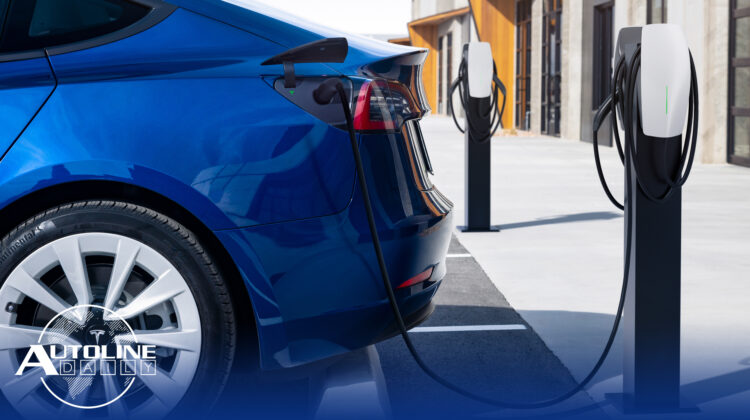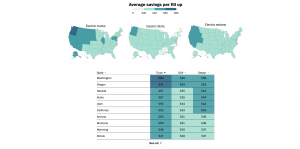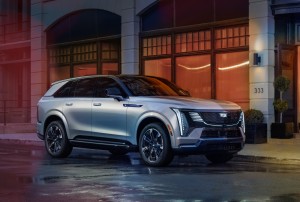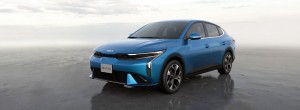
Listen to “AD #3624 – Charging Cheaper Than Pumping Gas; Cadillac Reveals All-Electric Escalade; Mahle Improves Battery Cooling” on Spreaker.
Follow us on social media:
Runtime: 11:56
0:00 Charging Cheaper Than Pumping Gas
1:14 VW Triples ID.3 Sales in China
2:32 Rivian Slashes Costs, Still Loses Billions
4:08 Meet the Electric Cadillac Escalade
5:59 Bentley Intros “Sustainable” Leather
6:40 Mahle Improves Battery Cooling
7:28 All-New Kia K3 (Forte)
8:26 Hyundai Not Offering New PHEV Santa Fe in the U.S.
Visit our sponsors to thank them for their support of Autoline Daily: Bridgestone, Intrepid Control Systems, Schaeffler and Teijin.
This is Autoline Daily, the show dedicated to enthusiasts of the global automotive industry.
CHARGING CHEAPER THAN PUMPING GAS
Some people believe it’s more expensive to charge an EV than it is to fill a car with gas in the U.S. So the Washington Post did the math to find out the truth with help from the think tank Energy Innovation. As you might suspect, the answer isn’t straightforward because prices vary charger by charger and state by state. Plus road taxes, rebates and battery efficiency all affect the outcome. But the bottom line is that it is cheaper to charge an EV in all 50 states. A driver that travels an average of 14,000 miles per year will save $700 a year with an electric SUV or sedan and $1,000 with an EV pickup. That’s with daily driving. Taking an EV on a road trip is a bit of a different story. In most cases, it’s still more expensive to use gas but there are some instances where the EV costs more. That’s because of the premium you have to pay for Level 3 fast chargers.
VW ID3 TRIPLES SALES IN CHINA
Volkswagen is desperate to maintain its market share in China, so it slashed the prices of its ID.3 and saw an immediate bounce in sales. At its launch two years ago, the ID.3 was priced at $23,000 in China and sales went nowhere. So VW cut the price to $19,700 but that didn’t help much, either. So last month it chopped the price to $16,500 and all of a sudden it tripled sales to about 7,400 units. Even so, it trails far behind its top competitors. The BYD Dolphin and Atto 3 each sold three times more than the ID.3. As for its other EVs in China, so far VW has not slashed prices of the ID.4 or ID.6 and their sales reflect that. It sold 4,000 ID.4s and only 1,500 ID.6s. Cutting prices by thousands is an expensive way to get market share, but right now it looks like the only way that Volkswagen can get market share in China. It has about 20% of the market with ICE vehicles, but only about 3% with BEVs.
RIVIAN SLASHES COSTS, LOSES $1.2 BILLION
Rivian reported its Q2 earnings and it’s a story about cost cutting. The EV startup reduced its headcount, pushed some capital expenditures into next year, and negotiated lower prices with some suppliers. But it also cut costs by launching its own electric motor called Enduro, as well as its own power electronics, both of which are made in-house. It also started using lower cost LFP batteries. Next year, a new electronic architecture is expected to get rid of 60 ECUs and 25% of the wiring in its vehicles. But even with all that cost cutting action, Rivian still lost money. Here are the numbers. It sold 12,640 vehicles, which was 50% more than Q1. That brought in $1.1 billion of revenue, including $34 million from selling regulatory credits. It posted an operating loss of $1.3 billion, a net loss of $1.2 billion and it burned through $1.3 billion of cash. Rivian says its focused on boosting production, which will be its fastest path to profitability.
MEET THE ELECTRIC CADILLAC ESCALADE
Cadillac revealed a new all-electric SUV based on the Ultium platform, called the Escalade IQ or Escalade-ick, which is how I like to pronounce it because that’s how you say the names of its other EVs; Lyriq and Celestiq. Even though it rides on a completely different platform than the gas-powered Escalade, I don’t think there’s any denying the Escalade IQ looks like an Escalade. But there’s still a strong resemblance to the Lyriq and Celestiq as well. Overall it seems like Cadillac has given the Escalade IQ more of a design tie-in to the Celestiq, which makes sense because it will carry an estimated starting price of $130,000 including destination charges. And I think the similarities also carry over into the interior, like the pillar-to-pillar display screen to the secondary screen on the center console and even the pattern on the seats. But now let’s get to the hardware. The Escalade IQ features a 200 kWh battery pack that provides an estimated 450 miles or 724 kilometers of range. It feeds energy into two electric motors that provide AWD and combine for 680 horsepower and 615 lb-ft of torque. But there’s also a “Velocity Max” mode that bumps that up to 750 horsepower, which Cadillac estimates will drop the 0-60 time down to under 5 seconds. A few other highlights of the Escalade IQ are MagneRide suspension, 4-wheel disc brakes and 24-inch wheels. Production will start next summer at GM’s Detroit-Hamtramck plant in Michigan.
BENTLEY INTROS “SUSTAINABLE” LEATHER
Bentley is introducing a new type of leather for its vehicles that uses a more sustainable tanning process. The tanning agent, which comes from byproducts created from making olive oil, doesn’t contain harmful metals or minerals. And the whole process uses less water than conventional tanning. The leather debuts in a new model Bentley will unveil at Monterey Car Week, which is this month. Even though the tanning process is more sustainable, Bentley is bucking the industry trend. Most automakers are getting rid of leather entirely because they don’t want to be seen as being cruel to animals.
MAHLE IMPROVES BATTERY COOLING
The German supplier Mahle says it developed a breakthrough to help make batteries more efficient. By copying nature, it created a new battery cooling plate, which features channels that run in all different directions. This causes the coolant in those channels to flow differently, which increases the cooling performance by 10%. And because of structural improvements, the cooling plate uses 15% less material. This is a simple example of how the auto industry is attacking all the challenges presented by electric vehicles, like keeping the battery at the proper temperature. The internal combustion engine saw 130 years worth of improvements, and now we’re seeing the same thing happen with BEVs.
ALL NEW KIA K3 (FORTE)
Kia revealed an all-new version of the K3, which is a small sedan it sells in a number of markets, including under the name Forte. So, we wouldn’t be surprised to see an announcement in the U.S. in the next several months. Kia is going with a much bolder design under its ‘Opposites United’ styling philosophy with very distinctive lighting and a layered and somewhat chunky front fascia. The interior is modest, matching the car’s affordability, and is highlighted by a floating display screen on the dash. Power will come from one of three 4 cylinder engines that can be mated to manual and automatic transmissions. The main two engines are a 1.6L unit that makes roughly 120 horsepower and a new 2.0L engine that makes about 150 horsepower. The new K3 will go on sale before the end of the year.
HYUNDAI NOT OFFERING PHEV SANTA FE IN THE U.S.
Speaking of the Hyundai Group, it shocked us a couple weeks back with the sophisticated new styling of the Santa Fe. And now we can give you some of the specs on that model. In Korea and North America the new Santa Fe will be available with a turbocharged 1.6L hybrid setup that makes about 180 horsepower or a turbocharged 2.5L unit that makes roughly 280 horsepower, which provides best in the lineup acceleration of 0-100 km/h in 8 seconds. Europe will also get the 1.6L hybrid, but it gets a PHEV version as well. Hyundai doesn’t say how big the battery is or how much range it has, but it also uses a turbocharged 1.6L engine and has a combined output of about 160 horsepower. The new Santa Fe goes on sale in Korea later this year, followed by North America and Europe early next year. And it also looks like Hyundai is considering going off-roading with the new Santa Fe, showing off this concept, called the XRT that is tailored to an outdoor lifestyle.
WILL THE UAW GO ON STRIKE?
Will the UAW go on strike next month? That’s the hottest topic in the US auto industry right now. Marick Masters, a professor at Wayne State University in Detroit who specializes in labor issues, says the UAW’s demands would push labor costs to $150 an hour. He says that would be financially unsustainable for GM, Ford and Stellantis, because it would make them uncompetitive. By the way, Marick Masters will be on Autoline After Hours this afternoon. And the show will be all about the looming UAW strike. Kalea Hall from the Detroit news will also join John and Gary and we invite you to tune in when the show goes live at 3 pm eastern time.
But that’s the end of today’s show. Thanks for joining us.
Thanks to our partner for embedding Autoline Daily on its website: WardsAuto.com
Seamus and Sean McElroy cover the latest news in the automotive industry for Autoline Daily.










